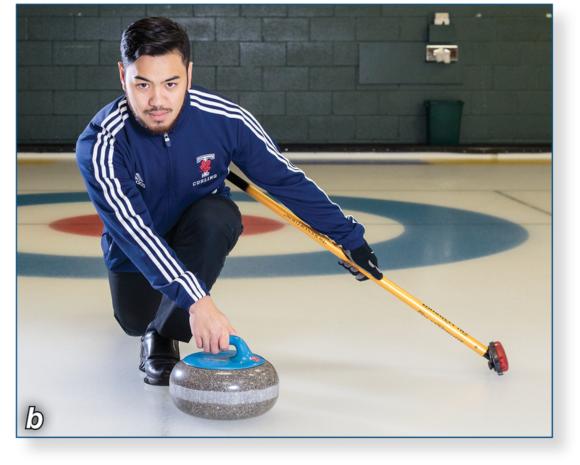Being Critical and Knowing the Break Point
This is an excerpt from Curling: Steps to Success by Sean Turriff.
Being Critical
A critical eye is also extremely important when reading the ice. Weight and line have a great impact on the curl for any given shot; however, another major factor that affects the curl is the release and rotation applied to a stone. A player may slide down a particular line, for instance, but give the stone a slight sideways push upon release that propels it down a different line than intended. This type of motion is often referred to as setting the stone. Players can set the stone out, meaning away from the body during the release (figure 6.2a), or they can set the stone in, meaning closer to the body (figure 6.2b).This is often related to which handle has been thrown on the stone. Setting a stone puts it on a different path than the one you are sliding down, and if you do not realize you have done it, it can give you a false impression about what is happening on the ice. At the top levels, players will practice purposely setting the stone in order to get different effects or amounts of curl. This is a very-high level skill that should not be considered at the beginner level. Players watching the shot need to observe the release to make sure nothing from the release affected the line.


Setting the stone in the delivery: (a) setting the stone out; (b) setting the stone in.
Another factor in the release that can affect the curl is the amount of rotation on the stone. Stones with little rotation will curl more than stones with more rotation. If a shot has less than the desired rotation on it, there will be an exaggerated curl. If a shot has more than the desired rotation, then it will have less curl than expected. If you do not observe this portion of the delivery, then you may get a false impression of the actual amount of curl. It may sound tempting to try to manipulate the amount of curl by changing the amount of rotation you put on the stone. In theory, this can be done, and at the highest levels it occasionally is, often to try to get curl on ice that is otherwise very straight. Again, this requires an extremely high skill level and should not be attempted by beginners. Instead, you should strive for consistency.
On most ice surfaces, rotations of more or less than 2 1/2 to 3 1/2 rotations will give you unpredictable curl. This is the reason we strive to hit that sweet spot of rotation on our shots - that amount of rotation yields the most consistent curl.
As a thrower, you need to be honest with yourself and critical of your performance so you can give the rest of the team an accurate impression of how well you threw your shot. If you know, for instance, that you shoved a rock off the line but no one else on your team detected it, you need to relay that information as soon as possible to your brushers, then let your skip know so she can factor that information into the result observed on your shot.
The impact of the release is one reason that players should be critical of the information they observe when watching their opposition throw. It can be misleading to watch your opponents throw if you are not familiar with their releases. Teams will be quite familiar with their own releases and so will be used to the idiosyncrasies in curl that result from their deliveries. Unless you have a critical eye, you may miss these small movements that have a big impact.
Misstep
You don't observe the release when watching a shot.
Correction
Establish a habit of specifically watching as the rock leaves the player's hand and then counting the rock's rotations. Also get into the habit of standing in line with the shot as you watch it rather than to the side. Both will give you clues about how clean the release was.
Break Point
Another factor that players need to understand is the nature of the path the stone takes. You know the path is a curve, but the exact nature of that arc is not always the same. Sometimes a stone will begin to curl immediately upon release, but most commonly, the stone will travel in a straight line extending from the slide path for a certain distance, then break into a curve. It is very important to understand where this break point is.
The impact of brushers needs to be considered in order to accurately read the ice. Brushing reduces the amount of curl on a given shot, although how much depends heavily on how good the brushers are. However, the straightening effect that brushers have on a shot is usually higher before the break point. Once the stone begins to curl significantly, it is harder to reduce the curl with brushing.
Again, this is another factor that can be influenced by the release. If one stone is released much earlier than another, the break point will come earlier. For this reason, teams often work to develop a common release point to reduce the factors that skips need to keep in mind when calling ice for shots. Figure 6.3 demonstrates how a different release point will have a different result even with the same initial target.

Break point and the effect of release.
Learn more about Curling: Steps to Success.
More Excerpts From Curling: Steps to SuccessSHOP

Get the latest insights with regular newsletters, plus periodic product information and special insider offers.
JOIN NOW


